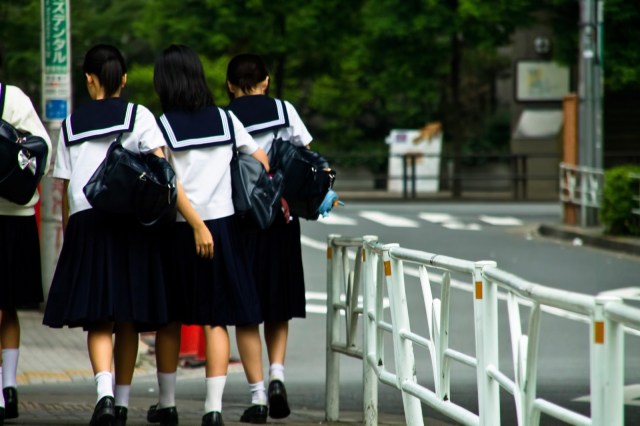
Law association calls practice a violation of human rights.
Almost all schools in Japan require their students to wear uniforms, and often even have rules about what kind of bags and hair ties are acceptable. But perhaps the strangest point of dress codes in Japan can be found at schools which officially state that students must wear plain white underwear.
While not every school has such a requirement, it’s common enough that a recent Saga Prefectural Bar Association study of 22 public middle schools in Saga City found that a majority of them, 13, have such rules in place for their students. The ostensible rationale is that the children’s undergarments should be simple and chaste so as not to cause distractions or contribute to a sexualized atmosphere, and white underwear, particularly white bras, are the least likely color to show a visible outline from under the students’ uniforms.
In and of themselves, the goals are understandable, and while it’s kind of weird to phrase the rule as “white underwear only” instead of “visible underwear colors not allowed,” in practice as long as the non-white underwear isn’t visible, no one will know it’s not white, and the students won’t get in trouble for it, right? Not necessarily. The bar association’s study found that at least one school with the rule, if not more, periodically checks what color of bra female students are wearing that day.
The students (who would be between the ages of 12 and 15) aren’t required to take off their tops for the inspections, but instead a teacher pulls one of the girls’ bra straps up through the collar of her blouse to check its color. The check is performed, at least, by a female teacher, but the bar association still finds the practice reprehensible, saying:
“Commanding someone to show their underwear is a violation of a person’s human rights. It is not acceptable simply because it is a child who is being given the command.”
The statement was part of a report submitted by the bar association to the Saga Prefectural Board of Education and local PTA organizations calling for a reform of school rules. Other questionable regulations discussed in the report include bans on “soft mohawk” hairstyles, not allowing students to wear mufflers when in uniform, and different dress code/hair style rules depending on the student’s gender. Also discussed is the potential confusion from schools having both rules restricting social media use, in the interest of protecting students’ privacy, yet requiring visible name tags on their uniforms, thus revealing their names to passersby on their way to/from campus.
The bar association urges schools to reconsider whether their rules actually have a positive effect on the quality of the students’ education, particularly in the modern era, and to take student input into consideration when making revisions in order to help cultivate a feeling of mutual understanding.
Sources: Yomiuri Shimbun via Livedoor News via Jin, Saga Shimbun Live via Hachima Kiko
Top image: Pakutaso
● Want to hear about SoraNews24’s latest articles as soon as they’re published? Follow us on Facebook and Twitter!

 Public schools in Japan’s Saga Prefecture will no longer regulate/check students’ underwear color
Public schools in Japan’s Saga Prefecture will no longer regulate/check students’ underwear color Majority of Nagasaki high schools and middle schools have white-underwear-only rules, study finds
Majority of Nagasaki high schools and middle schools have white-underwear-only rules, study finds Line up in the hall, open your shirts, show your bras – Real instructions from one Japanese school
Line up in the hall, open your shirts, show your bras – Real instructions from one Japanese school All Tokyo public high schools abolish rules forcing students to dye non-black hair, underwear color regs
All Tokyo public high schools abolish rules forcing students to dye non-black hair, underwear color regs Japanese high schools abolish old rules, provide freedom with underwear, hair and dating
Japanese high schools abolish old rules, provide freedom with underwear, hair and dating That time Seiji called JASRAC to ask why he didn’t get paid royalties for his song being on TV
That time Seiji called JASRAC to ask why he didn’t get paid royalties for his song being on TV Cup Noodle tries an authentic Jiro-style ramen, but something’s not quite right
Cup Noodle tries an authentic Jiro-style ramen, but something’s not quite right Hayao Miyazaki says Happy New Year to Studio Ghibli fans with new art for Year of the Horse
Hayao Miyazaki says Happy New Year to Studio Ghibli fans with new art for Year of the Horse Drinking sake just got more convenient with convenience store Family Mart’s new canned brews
Drinking sake just got more convenient with convenience store Family Mart’s new canned brews We eat at three Japanese family restaurants to find the one with the best-value breakfast
We eat at three Japanese family restaurants to find the one with the best-value breakfast Pizza Hut Japan’s hot lucky bags are perfect for a New Year’s pizza party
Pizza Hut Japan’s hot lucky bags are perfect for a New Year’s pizza party The most preposterous “adult” gacha capsule toys at Akihabara Station
The most preposterous “adult” gacha capsule toys at Akihabara Station Super Crazy Kun wins seat in Toda City Council election
Super Crazy Kun wins seat in Toda City Council election Is it rude to sing along at concerts in Japan? We ask a pro musician for his take
Is it rude to sing along at concerts in Japan? We ask a pro musician for his take Studio Ghibli unleashes Turnip Head on the world
Studio Ghibli unleashes Turnip Head on the world Starbucks Japan ready to get Year of the Horse started with adorable drinkware and plushies【Pics】
Starbucks Japan ready to get Year of the Horse started with adorable drinkware and plushies【Pics】 Cyberpunk anime meets traditional culture in Ghost in the Shell gold leaf Japanese changing screens
Cyberpunk anime meets traditional culture in Ghost in the Shell gold leaf Japanese changing screens 7 great places to see Mt. Fuji from without having to climb it
7 great places to see Mt. Fuji from without having to climb it Hello Kitty Choco Egg figures are an adorable trip through three periods of Japanese pop culture【Pics】
Hello Kitty Choco Egg figures are an adorable trip through three periods of Japanese pop culture【Pics】 7-Eleven Japan’s ramen-cooking robot whipped us up a bowl of noodles【Taste test】
7-Eleven Japan’s ramen-cooking robot whipped us up a bowl of noodles【Taste test】 We found possibly the quietest Japanese-style hotel in Tokyo’s bustling Shinjuku district
We found possibly the quietest Japanese-style hotel in Tokyo’s bustling Shinjuku district Japan’s otoshidama tradition of giving kids money at New Year’s gets a social welfare upgrade
Japan’s otoshidama tradition of giving kids money at New Year’s gets a social welfare upgrade Sumo Sanrio! Hello Kitty and pals team up with Japan Sumo Association for new merch【Pics】
Sumo Sanrio! Hello Kitty and pals team up with Japan Sumo Association for new merch【Pics】 More Than a Capsule Stay: Why Solo Travelers Choose “global cabin Yokohama Chinatown”
More Than a Capsule Stay: Why Solo Travelers Choose “global cabin Yokohama Chinatown” Japan’s oldest largetooth sawfish in captivity back on display in Mie Prefecture
Japan’s oldest largetooth sawfish in captivity back on display in Mie Prefecture 7-Eleven Japan starts new temporary luggage storage service in over 300 branches
7-Eleven Japan starts new temporary luggage storage service in over 300 branches Disillusionment at Tsukiji’s tourist-target prices led us to a great ramen restaurant in Tokyo
Disillusionment at Tsukiji’s tourist-target prices led us to a great ramen restaurant in Tokyo Starbucks teams up with 166-year-old Kyoto doll maker for Year of the Horse decorations【Photos】
Starbucks teams up with 166-year-old Kyoto doll maker for Year of the Horse decorations【Photos】 Tokyo considering law requiring more trash cans following litter increase in heavily touristed area
Tokyo considering law requiring more trash cans following litter increase in heavily touristed area Tokyo’s Tsukiji sushi neighborhood asks tour groups to stay away for the rest of the month
Tokyo’s Tsukiji sushi neighborhood asks tour groups to stay away for the rest of the month Tokyo event lets you travel back in time, for free, to celebrate 100 years since Showa era start
Tokyo event lets you travel back in time, for free, to celebrate 100 years since Showa era start Sanrio theme park in Japan announces plans to expand into a Sanrio resort
Sanrio theme park in Japan announces plans to expand into a Sanrio resort Japan may add Japanese language proficiency, lifestyle classes to permanent foreign resident requirements
Japan may add Japanese language proficiency, lifestyle classes to permanent foreign resident requirements Stamina-destroying “Paralysis Noodles” are Tokyo’s newest over-the-top ramen innovation
Stamina-destroying “Paralysis Noodles” are Tokyo’s newest over-the-top ramen innovation Survey asks foreign tourists what bothered them in Japan, more than half gave same answer
Survey asks foreign tourists what bothered them in Japan, more than half gave same answer Japan’s human washing machines will go on sale to general public, demos to be held in Tokyo
Japan’s human washing machines will go on sale to general public, demos to be held in Tokyo Japan’s deadliest food claims more victims, but why do people keep eating it for New Year’s?
Japan’s deadliest food claims more victims, but why do people keep eating it for New Year’s? We deeply regret going into this tunnel on our walk in the mountains of Japan
We deeply regret going into this tunnel on our walk in the mountains of Japan Studio Ghibli releases Kodama forest spirits from Princess Mononoke to light up your home
Studio Ghibli releases Kodama forest spirits from Princess Mononoke to light up your home Major Japanese hotel chain says reservations via overseas booking sites may not be valid
Major Japanese hotel chain says reservations via overseas booking sites may not be valid Put sesame oil in your coffee? Japanese maker says it’s the best way to start your day【Taste test】
Put sesame oil in your coffee? Japanese maker says it’s the best way to start your day【Taste test】 No more using real katana for tourism activities, Japan’s National Police Agency says
No more using real katana for tourism activities, Japan’s National Police Agency says Starbucks Japan reveals new sakura drinkware collection, inspired by evening cherry blossoms
Starbucks Japan reveals new sakura drinkware collection, inspired by evening cherry blossoms Updated cherry blossom forecast shows extra-long sakura season for Japan this year
Updated cherry blossom forecast shows extra-long sakura season for Japan this year Student in Japan misses week of class after school won’t let him wear sweatshirt on snowy day
Student in Japan misses week of class after school won’t let him wear sweatshirt on snowy day Some Japanese elementary schools don’t let kids wear underwear during P.E., and parents are mad
Some Japanese elementary schools don’t let kids wear underwear during P.E., and parents are mad Japanese schoolgirl points out an especially dumb part of her school’s “no tights” dress code
Japanese schoolgirl points out an especially dumb part of her school’s “no tights” dress code Dumb Japanese school dress codes — Coronavirus winter edition
Dumb Japanese school dress codes — Coronavirus winter edition Tokyo junior high school demands students wear white underwear as part of dress code
Tokyo junior high school demands students wear white underwear as part of dress code Manga artist wants Japanese teachers to feel, for two seconds, how dumb their girls’ dress code is
Manga artist wants Japanese teachers to feel, for two seconds, how dumb their girls’ dress code is Elementary and junior high students speak out on Japan’s strangest school rules
Elementary and junior high students speak out on Japan’s strangest school rules Japanese junior high school girl removed for class from three days for grooming her eyebrows
Japanese junior high school girl removed for class from three days for grooming her eyebrows Japanese school renames boys, girls uniforms as “Type I” and “Type II” in gender identity reform
Japanese school renames boys, girls uniforms as “Type I” and “Type II” in gender identity reform Head of Tokyo board of education gets asked about dumb school hairstyle rule, gives dumb answer
Head of Tokyo board of education gets asked about dumb school hairstyle rule, gives dumb answer Japanese public school to allow male students to wear skirts, chest ribbons as part of uniform
Japanese public school to allow male students to wear skirts, chest ribbons as part of uniform Students confused over Japanese school banning ponytails for “conjuring lustful feelings”
Students confused over Japanese school banning ponytails for “conjuring lustful feelings” “Students are only allowed three sneezes in class” Japanese people share their worst school rules
“Students are only allowed three sneezes in class” Japanese people share their worst school rules Petition to allow students to choose what they wear to school gathers almost 19,000 signatures
Petition to allow students to choose what they wear to school gathers almost 19,000 signatures Japanese high school teachers forcibly cut off hair that was “too long” from 44 students
Japanese high school teachers forcibly cut off hair that was “too long” from 44 students Former AKB48 member speaks out against Osaka school that forced its student to dye her hair
Former AKB48 member speaks out against Osaka school that forced its student to dye her hair
Leave a Reply